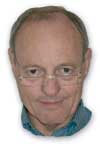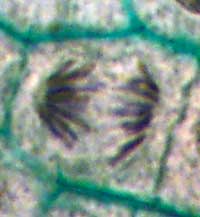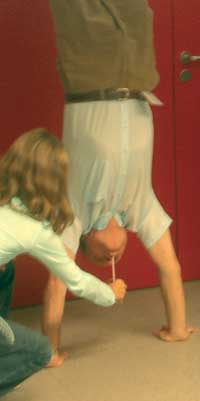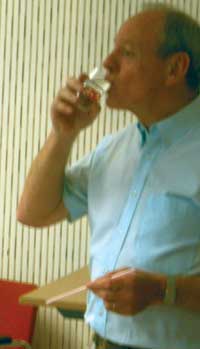Handstands and ties: a career in teaching Inspire article
John Watson, “the teacher who does handstands in class”, reminisces about what drew him to teach biology, shares memorable moments from his 38-year teaching career, and explains how scientists can help to inspire science teaching.

Why did you decide to become a science teacher?
I have always enjoyed working with children. When I was at school, I became a very active member of a children’s theatre group set up by my drama teacher. We were called the Pied Piper Players because we would parade through a park or an inner city housing estate to collect an audience and then perform a play with a lot of improvisation and audience participation, using the characters of the Commedia dell’Arte.
After university, with an MSc in applied genetics, I was qualified as a plant or animal breeder. After a quick search, though, the only job I found was breeding tomatoes. I hate tomatoes! So I decided to use my biology training in teaching instead – and I have never regretted my choice.

Can you tell us about a particularly memorable moment in your career?
I arrived at my classroom a few years ago to find an unexpected inspector who wanted to see what I was doing. Obviously, I invited him in and got on with the lesson. I was teaching mitosis, a topic I love, and the blackboard was covered in diagrams. To demonstrate the separation of chromatids at anaphase, I like to take two ties that are a little intertwined and pull them apart at the middle on a desk. The ties make a wonderful ‘V’ shape just like the chromatids as they are pulled to the poles. I was wearing a tie but I needed another, and the only other person in the room with a tie was the inspector. The students were delighted when I asked him to “undress” and he went along with the fun with a big smile on his face.

You’ve been involved in developing the science syllabus and a textbook to teach the syllabus. Could you tell us about it?
Currently, I teach in Luxembourg at the European School. The European Schools are unique: we have teachers and students from every country in the European Union and we teach sciences in 11 languages, but we all use the same syllabus. Obviously writing the syllabus is complicated, and requires teachers and inspectors of different nationalities to find a European compromise about what should be taught. I personally find the process very stimulating, though it can be long and discussions do sometimes go round in circles.
At a meeting of biology teachers in 1993, we had a big discussion about the diagrams to use in the baccalaureate exam. We decided that the only way to make the exam fair for all students was to produce our own diagrams. This idea developed into a project to produce our whole biology syllabus in diagram form with annotations in all languages. We called the book Eurobio and it has proved very popular (especially with new teachers) and is used in all 13 European Schools.
Since 1978, I have been a member of the biology commission, which is the group responsible for writing the biology syllabus for the European Schools, and have been involved in the writing and development of the syllabus for almost 30 years. Additionally, I have organised all the in-service training courses for biologists in the European Schools since 1980. These responsibilities add to the variety and satisfaction of my job – and I believe that interested teachers can, with a little effort, put themselves in a position to advise and even take part in policy making.
What do you think scientists most need to know about science in the classroom?
Science is moving at a tremendous pace and much of what is new cannot be done in schools; there is just not enough money. But if scientists could develop simple simulations so that we could teach the principles in an exciting and stimulating way, some of this progress in science would make its way into schools faster. A good example is the virtual microarray game from the European Learning Laboratory for the Life Sciences. In the laboratory, DNA chips trace the activity of genes by detecting the mRNA they produce; the virtual microarray simulates a DNA chip using a mat and lots of coloured lightsw1. For my lessons, I adapted the simulation slightly by replacing the coloured lights with discs that fluoresce red and green under a screened UV lamp.
The other problem with introducing scientific developments into school is time: students are only in the classroom for a short amount of time each week. So we need protocols that can be completed in one or two lessons.
If the European Union gave you the money, what kind of project would you design to make a significant difference to teachers and their students?
Volvox!w2 This is a network of teachers, scientists, educational specialists and science communicators, established to share teaching resources between countries. It will provide biology teachers with laboratory protocols, classroom activities on the social impact of bioscience, accounts of the careers of young scientists and other resources to help motivate teachers and their students.
I also have an idea for a project to bring researchers and teachers together to develop protocols that will work in the classroom with the limited materials and time that are available. The researchers would supply the practical expertise and the teachers would know the limits of what can and cannot be done; this is how the virtual microarray game and other materials from the European Learning Laboratory for the Life Sciences were developed. If other research centres and universities around Europe set up programmes like this for local teachers, I am sure we would have lots of new materials in a short time.
The teacher who does handstands…


I met the daughter of a colleague recently, outside school. She was not a student I had ever taught and when her mother asked her if she knew me, she said, “Yes, he is the teacher who does handstands in class.” Whenever I teach peristalsis to a new class, I do a handstand and drink a glass of water ‘upwards’.
Web References
- w1 – The European Learning Laboratory for the Life Sciences (ELLS) is an education facility to bring secondary school teachers into a research laboratory. Based at the European Molecular Biology Laboratory in Heidelberg, Germany, ELLS welcomes European teachers to its free three-day practical workshops. Instructions for the virtual microarray are available in the ELLS TeachingBASE. See www.embl.org/ells/ for further details.
- w2 – For more details about Volvox, see www.eurovolvox.org.
Review
This is an excellent article for inspiring new teachers and improving science teaching. Such memorable teachers make a difference not only in the classroom but also to long-term educational programmes. Teaching sciences in an exciting and creative way involves students and makes them love science. Being a good teacher is like being a good actor; an actor who makes the audience part of the play. Good teachers like John Watson are working towards better global education, curricula and teaching materials.
I wish all teachers and scientists inspired their students like John Watson!
Myrto Pouangare, Cyprus





